| February 2009 Index | Home Page |
Editor’s Note: Ambitious research for teaching and learning in a critical arena. The statistics need amplification as more support for this format is accumulated and verified.
Design, Development, Implementation and Effectiveness of Web-based Learning Software for Number Systems
Vijay S. Kale
India
Abstract
e-learning is an umbrella term that is used to refer to any of the following: CBT (Computer Based Training using CD), WBT (Web-Based Training using PDFs, HTML pages or digital content created with tools like Flash-with or without animation, graphics, audio, video), video lectures (also known as Interactive Video Lectures - iVL) and audio lectures (also known as Interactive Audio Lectures - iAL), Live Virtual Classroom etc. e-learning enables the distribution of quality education easier, faster, in a more convenient manner. Contents can be easily modified.
To fulfill the needs of students and to achieve goals of the educational system, an attempt is being made to design, develop and implement a web based learning module of “Number system” of Digital Computer Electronic subject (Yashwantrao Chavan Maharatstra Open University (YCMOU) DCHMNT programme subject). The number system topic was chosen because of its importance in the computer field. Web pages are designed and developed with different media: text, graphics, tables, pictures, animation, audio/music etc. Interactivity in software is being developed by using java script and java applets. The self-instructional materials (SIM) have features such as interactivity, immediate feedback, and provide reinforcement or motivation.
The developed SIM is made available in CD form. It was implemented by using local area network. The SIM is loaded at local area network (LAN) server and multimedia PC’s are provided to access SIM.
India with a large geography, population and lack of teachers needs should take advantage of e- learning. It can raise the level of education, where technical education is expensive, opportunities are limited, and economic disparities exist. Although e-learning has potential in India, adoption has been slow and will need major efforts to increase awareness of its potential within the education community.
Keywords: distance education, self instructional material, e-learning, computer assisted learning, active learning, audio, video, multimedia, web page, hyper link, lan, internet, web based training, effectiveness.
Introduction
Advancing technology has opened many doors in education. Course materials are available to the learner in a variety of media, usually in four generations according to the technologies [Colletta 1996]. These are mailbag materials, education through air, computer based education, and technologies of immediate future (Internet based learning system) [Kumar 2000]. It is desirable that instructional materials have features such as interactivity, immediate feedback, reinforcement and/or motivation and should play a supervisory role like a tutor/instructor [Garg & Panda 2005, Zhang 2005]. There is a challenge to educators to make use of new technologies to develop a self-instructional material (SIM), to enhance instructional effectiveness for the content which is difficult to grasp [Garg et.al, 2008].
Computer simulations enhance students' problem solving skills by giving them an opportunity to practice and refine their higher-order thinking strategies [Gokhale, 1991, 1996]. In particular, computer simulation exercises based on the guided discovery learning theory can be designed to provide motivation, expose misconceptions and areas where knowledge is deficient, integrate information, and enhance transfer of learning [Mayer, 1992]. Mayer found that, when certain types of material are presented using multimedia techniques, retention increases by an average of 23%; when text and graphics are combined, retention increases goes up an average of 42%; and if the text of presentation is spoken rather than read it, students hear the words rather than read them, retention goes up an average of 30%. With the implementation of properly designed simulation activities, the role of the teacher changes from a transmitter of information to a facilitator of higher-order thinking skills [Aly et. al. 2004].
With the introduction of computers in the teaching/learning process and the emergence of the Internet, a large number of Web-based educational applications have been developed. Computer-assisted instruction plays a very important role in the modern education process and extensive research shows increasing evidence of the use of computers in the teaching/learning process. Some evidence has shown that computer assisted instruction, which focuses on higher-order learning in technical education, has been more effective than traditional instruction. However, comprehensive research is required to determine the best methodology to be applied to the design and development of computer-assisted instruction.
An attempt is made here to design and develop an interactive multimedia system (SIM) for the “Number Systems” in Digital Electronic subjects. The topic is selected due to its importance in computer and other control applications in real life. The web-based instructional technology is used to develop the multimedia SIM [Khan 1997]. The aspect called dynamic Internet is used to provide more interactivity to the learner [Mishra 1999]. Web pages represent the information with different media such as text, graphs, tables, picture, animation, audio etc. Learner interactivity is developed using hyperlinks, java script programs and applets. Java script programming is used to develop immediate feedback for supervised practice sessions. Supervised practice session means that a series of activities are presented by the computer to be carried out by the learner. At the end of each activity the system provides responses similar to a human tutor. Web pages are integrated by using hyperlinks.
Presently, the Internet is not used much in India for education because of the computer network problem (low speed down-loading of information). However, the Internet is expected to dominate instructional systems in the future. The authors developed a SIM that is available in compact disc (CD) form. In the future it will be possible to deliver this SIM on Internet.
In this study, the experimental group used the developed SIM for learning “Number systems”; the control group studied by traditional methods (printed material and counseling). The test was administered three times - as a pretest, posttest and retention test. The investigator analyzed test data to compare acquisition of knowledge and skills for each student against the predetermined objectives.
Such course material with variety of learning media fulfills the need of distance learners as well as it achieves the goals of educational system [Villamil 1998, Turoff 1995].
Y. C. M. Open University and DCHMNT programme
The Yashvantrao Chavan Maharastra Open University (YCMOU) was established in 1989. In university the school of continuing education was established in 1989. This school is committed to provide access to education to all sections of people through relevant courses in both formal and non-formal streams. The Diploma in Computer Hardware Maintenance and Network Technologies (DCHMNT) started in 1999. One of the program objectives for the DCHMNT program is to provide the basic knowledge about computer assembling, maintenance and networking. Completion of the course requires three subjects taught in one semester – two theory courses (DCE 101 and DCE 102) and one practical course (DCE 103). The minimum qualification for the course is Xth standard. Different learners have qualification as- XI (science, commerce and arts), First-year Science/Commerce/Arts, Second-year Science/Commerce/Arts, B.A., M.A., M. Com., etc. Learning is in the English language.
Learning mode
YCMO University has recognized different institutes or centers. Learners apply for admission to one of these centers. The Institute appoints counselors that have been accepted as accredited by YCMOU. Learners attend the counseling sessions. Counselors solve the learner’s difficulties.
Methodology:
The learner reads the instructional material (Book title- Digital Compute Electronics by Malvino and Brown) provided by YCMOU, Nashik. The learner discusses the instructional materials with the counselor to gain further understanding of concepts presented in the text.
Objectives of the research:
1. To provide sufficient knowledge of the subject to the learner.
2. To develop critical and analytical abilities.
3. To develop the ability to relate and use the knowledge in real life situations.
4. To develop a learner’s interactivity and technical competency in using the software
5. To make distance learning more attractive, effective and powerful.
Relevance to communication:
The form of Communication system is shown in Figure 1.
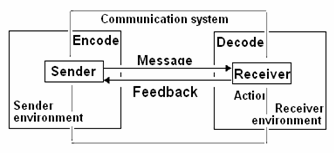
Fig. 1: Communication system
Sender: The person or body responsible for sending the messages is called the sender.
The Researcher acts as a Sender of messages (SIM) stored on CD-ROM.
Encoding: Sender puts information in the form that is suitable for the receiver. Software and hardware will convert stored information in memory into the audio and video form.
Receiver: This is a person or a body, which receives the message. Learner will see the computer monitor, and will hear audio from speaker/headphone. The learners are in the DCHMNT program of YCMOU. The learners will receive the message.
Decoding: The learner will interpret the message. If encoded wrongly, distortion likely to occur. Receiver will try to get meaning from displayed information and audio.
Message: The material from which the communication is constructed. Information included in the CD of module number systems. The module contains many web pages. Each web page is designed with text information, tables, java script, applet and audio. It also includes a self-test with a feedback mechanism for each sub topic and a module to test the learning.
Distortion: Can occur in decoding when the receiver interprets a message in a different way.
Medium of the message: Web based multimedia SIM software in English.
Mode of communication: The communication is meant for a specific target group.
Aim of communication: Understanding concepts of Number systems and improve skills in problem solving.
Noise: This is the name given to any factors, which prevent the proper exchange of information between the sender and the receiver.
Feedback: Objective questions will be asked at the time of learning on each topic in multimedia software. Student will have chance to select the correct answer from options provided and receive an immediate response on the screen. Multiple-Choice questions check the learning at the end of the Number Systems module.
Web-based Multimedia SIM Design and Development:
The goals of distance education can be achieved by using computer technology to develop SIM. The computer can be used to simulate complex situations, provide animated material, and enable instant response for effective positive reinforcement. Self-instructional material development involves the planning an activity unit, selecting instructional resources and media, developing and integrating learning experiences, testing and revision, and duplicating the instructional materials.
The steps in design and development of SIM are text selection, audio selection and recording, script writing, computer programming, web page design, multiple-choice question selection, graphics selection and preparation, and product first try [Steinmetz 1995, Gustafson 1996].
Parker [Parker, 1990] mentioned screen text details to ease of reading and to create learners interest. Screen text parameters include font types (Times New Roman), font size (10, 12, 14 pt), Line length (40 to 70 characters), text left alignment, smooth screen color selection etc.
The developed multimedia software is an integration of web pages. Each web page is designed in a frame format to increase the concentration of the readers. Different mouse click buttons are provided to the right side at the bottom of each page to interact with sub units and to perform certain activity such as HOME, NEXT, BACK etc. (Frame 1).
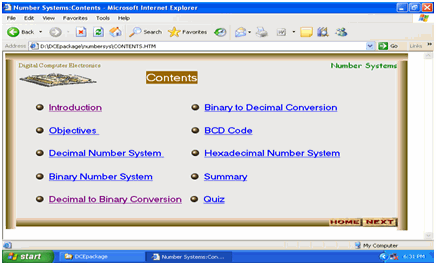
Frame 1: Number system contents
It shows contents of the module number system. It shows subtopic titles such as Introduction, Objectives, Number Systems and their Conversions. Summary and quiz are hyper-linked so that the learner gets the idea of sub-topics and has freedom to select a topic of interest.
One of the subtopic decimal to binary conversion of number system module is shown with Frame 2. Learner sees the video as well as hears the audio like a teacher talk in the classroom. In developed SIM learner can press refresh button to listen the audio number of times.
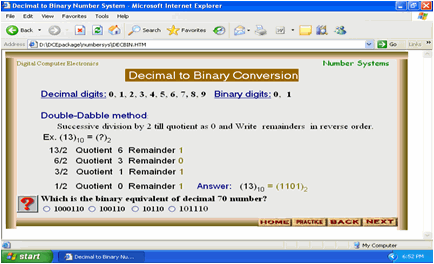
Frame 2: Decimal to binary conversion
To check the learning of topic, at the end of each frame, one multiple-choice question is asked related to the information displayed. Four choices are displayed with radio buttons to accept learner’s response using mouse click. When user clicks the radio button, a small frame is displayed indicating whether the answer is correct or not. A correct answer is confirmed immediately with a remark such as “Good, Your answer is correct” to motivate learner as shown in Frame 3. If the answer is not correct, a remark such as, your answer is not correct is displayed, followed by the correct answer. The learner gets the immediate response as he/she is guided through the learning process. It is a simulation of what a teacher does in the classroom.
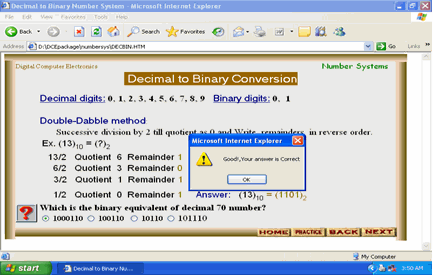
Frame 3: Interactivity and feedback mechanism.
Flexible activity selection is designed and developed by providing meaningful buttons labels. The learner can go to the next frame, back frame, home or practice session by clicking a button. Hyperlink buttons on the bottom border provide NEXT, BACK, HOME and PRACTICE. If the button labeled ‘NEXT’ is clicked, the learner will see the next frame. Similarly, if ‘BACK’ button is clicked, the previous frame will be displayed. If HOME is clicked the main topics and sub-topics are displayed on screen. The learner can select any subtopic to learn in sequence, skip items, or adapt to his or her personal preferences. Such mechanism is similar to a book; learners can select topics that meet their needs.
The button labeled ‘PRACTICE’ is to develop problem solving skills. The learner solves a particular problem. To obtain the answer,; he/she follows number of steps. If mistake is made in any step, the answer is wrong. The software checks every learner activity. Feedback to the learner provides a response similar to a human teacher. Java applets are developed for different number system conversations. The learner gets a numerical answer, such as the equivalent of the number system entered, in a provided input box. Frame 4 shows one such screen. These activities are designed to increase the confidence level of learner.
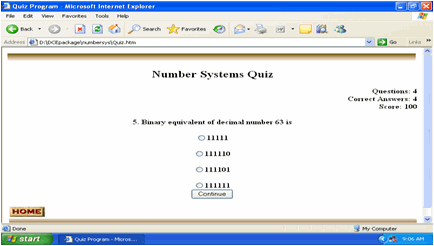
Frame 5: MCQ with its choices and feedback to display immediate result.
At the end of the module summary a quiz is provided. Frame 5 shows the multiple choice question with options. The response of the learner and score are displayed.
Implementation stages
A pretest was administered to students from DCHMNT program (Yashwant Institute, Pune) that have completed Digital Computer Electronics subject through regular counseling. The implementation procedure is shown in figure 2. The sample is divided in to experimental and control groups. These groups are formed by random method of sample selection.
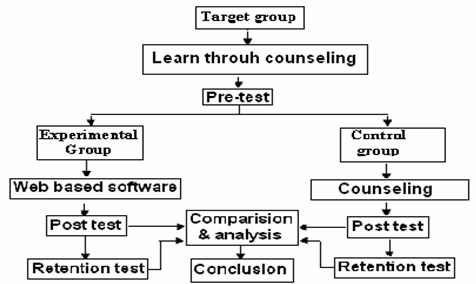
Figure 2: Implementation stages.
Tools Construction:
The investigator selected the Number system module of subject DCE 101 syllabus of DCHMNT programme of YCMOU. The module contents are:
a. Decimal number system
b. Binary number system
i. Decimal to binary conversion
ii. Binary to decimal conversion
c. Hexadecimal number system
i. Decimal to hexadecimal conversion
ii. Hexadecimal to decimal conversion
iii. Hexadecimal to binary conversion
iv. Binary to hexadecimal conversion
d. Digital codes
i. BCD number
ii. ASCII code
In the first phase, the pretest contained 25 multiple choice questions constructed to measure achievement. A tryout of the test was administered to 30 students of the DCHMNT program: DCE101 subject. The same test was administered to the same learners at a later date, and the two sets of scores correlated to determine the reliability of test items. Validity was measured by correlating the achievement test score. The pretest was administered to participating learners to assess prior knowledge of selected experiments and initial equivalence between groups.
In the second phase, web based computer software was given to the experimental group. The control group was taught by the traditional method. In the third phase, a posttest was administered to measure treatment effects. This test was designed to assess the content that was previously learned and how students applied the learned material. The pretest, posttest and retention test were the same test. A retention test was conducted on both groups one month later.
Population and Sample
For convenience, the investigators limited this experiment to the YCMOU center Yashwant Institute PC hardware and networking institute, Pune, Maharastra (India). The centers are all over the Maharastra. The total population for DCHMNT program is approximately 700. Yashwant Institute was selected for samples because of its learner’s strength and availability of required hardware (LAN network).
Selection of Groups:
Respondents for the investigation were DCHMNT program digital computer electronics (Subject-DCE101) learners (first semester) of Yashwant Institute PC hardware and networking institute, Pune, Maharastra (India).
On the basis of learner performance in achievement test on the Number system, the students were divided into two groups (experimental and control), each with 27 learners. Sampling was done by a stratified random sampling method.
A ‘t’ test was administered to find out the significance of the difference between mean scores of the control group and experimental group in the pre test. The analysis provided that there was no significant difference between the two groups. It established the fact that the two groups selected on the basis of the achievement test were nearly equivalent.
Data collection
Data was collected with the help of pre-test, post test and retention tests to study the effectiveness of the SIM. The Experimental group used the developed interactive web based multimedia SIM for learning. Then a post-test was administered on experimental (EG) and control group (CG). Finally the retention test was administered on both groups after one month.
Analysis of Data
The main point of this study was to determine the results of adding web based software support to learning. After collecting the data, analysis was made. Mean, Standard deviation and Coefficient of correlation were calculated for the pre and posttest scores for the control group and experimental group. Using “t” test, significance of the difference between the mean of the pre, post and retention test was computed for both the groups separately. Further, relationship between pre and post test scores for control and experimental groups were studied. The significance of difference between the pretest, posttest and retention test scores for control group and experimental group was tested employing “t” test. The level of significance (alpha) was set at 0.01 for all tests of significance.
Achievement Test Analysis:
Table 1 summarizes the analysis of pre, post and retention test scores both the groups of DCHMNT learners.
A ‘t’ test was conducted on the pretest scores for two treatment groups. The mean of the pretest scores for the experimental group students (13.26) was not significantly different from the control group (12.85) (‘tcal’ =0.3346) at 0.05 alpha level. The mean of the pretest scores for the experimental group was not significantly different from the control group for all classification. Hence it was concluded that treatment groups were similar.
Table 1
The mean, standard deviation of pre, post and retention test
of control and experimental group.
Group | Test | Sample | Number systems | |
Mean | Std. dev. | |||
Control group | Pre | 27 | 12.85 | 4.41 |
Post | 27 | 14.33 | 4.532 | |
Retention | 27 | 14.15 | 3.37 | |
Experimental group | Pre | 27 | 13.26 | 4.60 |
Post | 27 | 19.37 | 2.57 | |
Retention | 27 | 18.46 | 3.35 | |
The mean of the post test scores (19.37) for the experimental group was significantly higher than the control group (14.33). This difference was significant at the 0.05 alpha levels (‘tcal’ = 5.029). Hence it was concluded that the knowledge level of experimental group learners was higher compared to control group students’ knowledge level.
The mean of the retention test scores (18.46) for the experimental group was significantly higher than the control group (14.15). This difference was significant at the 0.05 alpha levels (‘tcal’ = 4.712).
The mean score comparison of pre, post and retention test of control and experimental groups is shown in graph 1. It shows that the knowledge of experimental group students was raised higher and retention was better when compared to the control group.
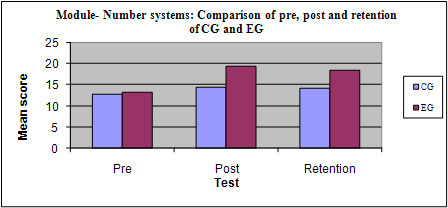
Graph 1: Mean score comparisons of pre, post and retention test of CG and EG.
Table1 show that there is significant difference of mean and standard deviation (SD) of post and retention test for experimental and control groups of DCHMNT learners. It indicates that mean score for post and retention of experimental group is at higher level than the control group. The result indicates that the web based software help the students to enhance their acquisition of knowledge, understanding and retention too.
Advantages of web-based multimedia SIM:
The advantages of interactive web-based multimedia are listed below:
- Learning is self-paced; retention is increased.
- The interactive nature of multimedia computer-based instruction assures an active and constructive learning process. Students can control of their own learning.
- The use of interactive multimedia will reduce the time required for learning.
- Interactive multimedia lesson use feedback for reinforcement.
The learning process can also be improved at the higher education level when the teacher presents online interactive multimedia as part of their class lectures. This can increase the students attention, clarify complex concepts and stimulate analytical thinking.
- Higher educational teaching-learning process can be significantly enhanced by the hypertext/hypermedia tool that is incorporated in the multimedia software.
- The SIM is low cost and available on CD.
- The content of developed SIM can be easily made available on Institute computer networks or stand-alone computer stations. This valuable campus service makes it possible for the learner to learn at any time, in his own way, for study, review, or make-up if he or she misses a particular topic or lecture.
- Education and training cost will be significantly reduced.
Equipment: Development of web based interactive multimedia software required multimedia computers and peripherals (Pentium IV, CD-R/W drive, Speakers/Headphone, Microphone etc.).
Software: Operating system Window 98/XP and other software such as Microsoft FrontPage, Microsoft Internet Explorer, Gold wave (recorder/editor, player), Java platform.
Recommended learner computer system: Pentium multimedia system with windows operating system, audio & video drivers, Microsoft Internet Explorer or equivalent, jdk.exe, speaker/ headphone.
Conclusion
Web based interactive multimedia software is designed and developed for module “Number systems”. It is the integration of web pages. Module sub units are presented in a frame format. A learner can see the video content as well as hear the audio. In the learning process, whether he/she has acquired sufficient knowledge or not is tested using a multiple choice question. When the learner selects the answer, feedback provides motivation and also guides the learners.
Once the learner starts problem solving, learning steps are checked and he/she is guided up to the final answer. At the end of module, interesting activity is given in the form of a quiz. To test the understanding of module, multiple choice questions (25) are given. Questions and the answer options (four) are displayed on the screen. The learner’s activity response is immediately displayed on the screen. Java script and Java applets increase the learner interactivity. If the learner has solved the problem and wants to check whether the answer is correct or not, this can be checked using a Java applet. Such effective use of technology in SIM will increase self-confidence of the learner.
Learner may learn by using their multiple senses, which will provide new and enriched experiences. The learning process is an active one where learners can learn on their own. The interactive lesson provides a stimulating environment that can improve the learning process by enhancing understanding and retention of the subject matter.
The module effectiveness was examined. After conducting a statistical analysis on the test scores, it was found that learners who used the web based software were significantly better on knowledge and problem skills than the students who were taught using counseling plus a print medium of instruction. The number system module analysis of control (CG) and experimental group (EG) shows that, the scores acquired by the experimental group in post and retention tests are higher than the control group. The results of study indicate that web based multimedia software for “Number system” is useful to enhance the knowledge, understanding, and problem solving skills and helps in retaining the acquired knowledge.
The learners may learn by using their multiple senses, which provide new and enriched experiences. The learning process is an active one, leaving the learners to learn by their own. The authors have developed a new form of SIM, which is available in compact disc (CD) form. It can be used by individual learner or group of learners by using a LAN server. In the future it will be possible to provide the SIM via the Internet. Course materials with a variety of learning media will fulfill the need of learners and achieve the goals of the educational system.
It is recommended that further research be conducted to evaluate the effects of using guided-discovery instructional strategies on enhancing the problem-solving ability of students with different achievement levels, using different academic subject material. Also, there is a need to investigate the different cognitive models that students employ in understanding and evaluating technical concepts. This will provide the research community with tools to design computer simulations for improvement of higher-order cognitive skills.
References:
1. Aly, M., Elen, J.,and Willems, G., (2004), “Instructional multimedia program versus standard lecture: a comparison of two methods for teaching the undergraduate orthodontic curriculum”, European Journal Of Dental Education, Vol. 8 ,Issue 1. pp 43-47.
2. Colletta,N.J., (1996), “ Formal, Nonformal and Informal Education”, International Encyclopedia of adult Education and training”, 2nd ed., PP-22-26, Pub. Pergamon.
3. Garg,S., Gupta,S., Dikshit, J., (2008), “Interface between education and emerging new technologies: Retrospect and prospects”, University news, vol. no. 38, September, pp. 22-28, New Delhi.
4. Garg, S. & Panda, S., (2005), “Initiative on online learning and educational multimedia: Interactive multimedia for distance and online learning”, Indian Journal of open learning, 14(1), PP. 97-98.
5. Gokhale, A. A., (1996), Effectiveness of Computer Simulation for Enhancing Higher Order Thinking , Journal of Industrial Teacher Education, 33(4), 36-46.
6. Gokhale, A. A., (1991), “Effectiveness of computer simulation versus lab, and sequencing of instruction, in teaching logic circuits”, Journal of Industrial Teacher Education, 29(1), PP. 1-12.
7. Gustafson, K.L., (1996), “Instructional design: Models”, International Encyclopedia of Adult Educational and Training” 2nd ed., PP 503-508, Pub. Pergamon.
8. Khan, Badrul H., (1997) “Educational Technology- Web based instruction”, New Jersey Publication.
9. Kumar, K.L., (2000), “Educational Technology”, New age information limited publisher, PP-307-308.
10. Mayer, R.E., (2001), “Multimedia learning”, Cambridge University press.
11. Mishra, S., (1999), “ An empirical analysis of interactivity in teleconference” Indian Journal of Open Learning”, Vol.8, No.3, PP.244-253.
12. Parker, R., (1990), “101 Design Solution for Desktop publishing”, Galgotia publications pvt. Ltd., New Delhi-11002.
13. Steinmetz,R., Nhrstedt,K., (1995), “Multimedia: Computing, communication and applications”, Prentice hall PTR, Upper Saddle River, NJ07458.
14. Turoff, M., “1995 International Conference on Computer assisted InstructionICCAI’95”, Designing a virtual classroom, PP.13,www.njit.edu/CCCC/VC/papers/Design.html.,pages 13.
15. Villamil, J., Molina, L., (1998), “ Multimedia production, planning and delivery”, Prentice Hall of India Pvt. Ltd.
16. Zhang, D., (2005), “Interactive multimedia based e-learning”, American journal of distance education, 19(3), 149-162.
About the Author:
| Vijay S. Kale is senior lecturer in electronics at Department of Electronic Science, K.T.H.M. College, Nashik (University of Pune), Maharashtra, India since last 21 years. He has completed his master degree with specialization in electronics (University of Pune 1984), Induction course (Technical teacher training institute 1885), Advanced Diploma in Computer Software and System Analysis (BTE, Mumbai 1993), M. Phil. in Electronic Science (University of Pune 1995) and short term course on embedded system design using microcontroller (University of Pune 2007). He has completed minor project funded by UGC (2000). He has attended as well as presented research papers in national, international conferences. He has actively participated in workshops/seminars on syllabus framing at University of Pune, Pune and YCMOU, Nashik. He worked as a counselor at YCMOU, IGNOU at Nashik center. |
Rajendra V. Vadnere is Director, School of Continuing Education, Yashwantrao Chavan Maharashtra Open University, Nashik, Maharashtra, India. He has completed his Ph.D. from IIT Mumbai. His present research interests are e-learning and its applications in open and distance education system. Email: raj_vad@yahoo.com or ce@ycmou.com |
